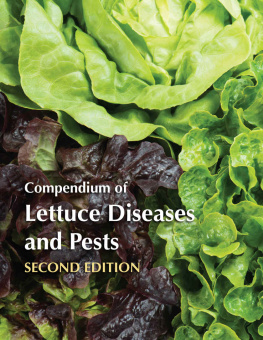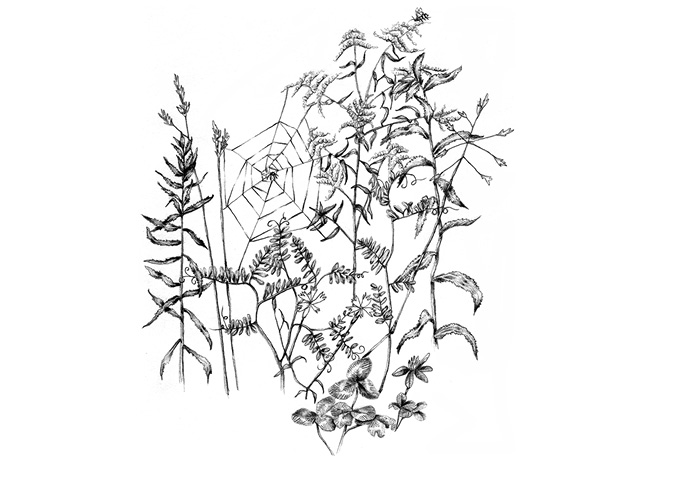

Organic Principles and Practices Handbook Series
A Project of the Northeast Organic Farming Association
Growing Healthy Vegetable Crops
Working with Nature to Control Diseases and Pests Organically
Revised and Updated
Brian Caldwell
Illustrated by Jocelyn Langer
Chelsea Green Publishing
White River Junction, Vermont
Copyright 2004, 2011 by the Northeast Organic Farming Association Interstate Council.
All rights reserved.
No part of this book may be transmitted or reproduced in any form by any means without permission in writing from the publisher.
Originally published in 2004 as Vegetable Crop Health: Helping Nature Control Diseases & Pests Organically.
Editorial Coordinator: Makenna Goodman
Project Manager: Bill Bokermann
Copy Editor: Cannon Labrie
Proofreader: Helen Walden
Indexer: Peggy Holloway
Designer: Peter Holm, Sterling Hill Productions
Printed in the United States of America
First Chelsea Green revised printing March, 2011
10 9 8 7 6 5 4 3 2 1 11 12 13 14
Our Commitment to Green Publishing
Chelsea Green sees publishing as a tool for cultural change and ecological stewardship. We strive to align our book manufacturing practices with our editorial mission and to reduce the impact of our business enterprise in the environment. We print our books and catalogs on chlorine-free recycled paper, using vegetable-based inks whenever possible. This book may cost slightly more because we use recycled paper, and we hope youll agree that its worth it. Chelsea Green is a member of the Green Press Initiative, a nonprofit coalition of publishers, manufacturers, and authors working to protect the worlds endangered forests and conserve natural resources. Growing Healthy Vegetable Crops was printed on Joy White, a 30-percent postconsumer recycled paper supplied by Thomson-Shore.
Library of Congress Cataloging-in-Publication Data
Caldwell, Brian Alan.
Growing healthy vegetable crops : working with nature to control diseases and pests organically / Brian Caldwell ; illustrated by Jocelyn Langer. -- Updated and rev.
p. cm. -- (Organic principles and practices handbook series)
A Project of the Northeast Organic Farming Association.
Previous edition published under the title Vegetable crop health: helping nature control diseases & pests organically. Barre, MA : NOFA Interstate Council, c2004.
Includes bibliographical references and index.
ISBN 978-1-60358-349-7
1. Vegetables--Diseases and pests. 2. Vegetables--Diseases and pests--Control. 3. Agricultural pests. 4. Agricultural pests--Control. I. Northeast Organic Farming Association. II. Title. III. Series: Organic principles and practices handbook series.
SB608.V4C35 2011
635.049--dc22
2010053672
eISBN: 9781603583503
Chelsea Green Publishing Company
Post Office Box 428
White River Junction, VT 05001
(802) 295-6300
www.chelseagreen.com
Best Practices for Farmers and Gardeners
The NOFA handbook series is designed to give a comprehensive view of key farming practices from the organic perspective. The content is geared to serious farmers, gardeners, and homesteaders and those looking to make the transition to organic practices.
Many readers may have arrived at their own best methods to suit their situations of place and pocketbook. These handbooks may help practitioners review and reconsider their concepts and practices in light of holistic biological realities, classic works, and recent research.
Organic agriculture has deep roots and a complex paradigm that stands in bold contrast to the industrialized conventional agriculture that is dominant today. Its critical that organic farming get a fair hearing in the public arenaand that farmers have access not only to the real dirt on organic methods and practices but also to the concepts behind them.
About This Series
The Northeast Organic Farming Association (NOFA) is one of the oldest organic agriculture organizations in the country, dedicated to organic food production and a safer, healthier environment. NOFA has independent chapters in Connecticut, Massachusetts, New Hampshire, New Jersey, New York, Rhode Island, and Vermont.
This handbook series began with a gift to NOFA/Mass and continues under the NOFA Interstate Council with support from NOFA/Mass and a generous grant from Sustainable Agriculture Research and Education (SARE). The project has utilized the expertise of NOFA members and other organic farmers and educators in the Northeast as writers and reviewers. Help also came from the Pennsylvania Association for Sustainable Agriculture and from the Maine Organic Farmers and Gardeners Association.
Jocelyn Langer illustrated the series, and Jonathan von Ranson edited it and coordinated the project. The Manuals Project Committee included Bill Duesing, Steve Gilman, Elizabeth Henderson, Julie Rawson, and Jonathan von Ranson. The committee thanks SARE and the wonderful farmers and educators whose willing commitment it represents.
To my family
This book is offered as a practical guide to effective organic-vegetable pest management for northeast growers, based on the experience and understanding of farmers and researchers.
Contents
What do we see when we look at a relatively undisturbed area, for instance, a forest or old field meadow? At first glance, we see a diverse mixture of primarily healthy plants. We see very little bare soil, no harvest removal, minimal nutrient deficiency, plants of different heights, and intense competition for light. Looking a little closer, we see some pest damagegalls on the goldenrod and a few holes in leaves. A great diversity of herbivores and predators are present, but at relatively low levels. Plant productivity is high. Many ecological niches are present beneath the plant canopy, fueled by decomposition.
Not so much is known about what is going on belowground. Roots explore the whole soil profile. Compaction is minimal. Aeration is as good as it can be, with hummocks creating zones of good drainage even on wet sites. The species composition of the soil community is very diverse, and differs from that of agricultural soil. Because of lack of tillage, fungi are better established. Soil organic matter is slowly increasing to high levels. Nutrient leaching is low.
We can try to gain insights from these natural examples, to help us better manage our crop ecosystems. But a farm field is profoundly different. In agriculture, we need to harvest crops and remove their organic matter from the field; we often need to till the soil, destroying a habitat above- and belowground, to establish our edible crop plants. Many crop plants are derived from early-succession plants that can take advantage of disturbed ground to grow and reproduce rapidly. Their pests are those insects that are able to locate their hosts within diverse landscapes, and also can reproduce rapidly once hosts are found. Agricultural systems are inherently different from less-disturbed natural models.
While there are many kinds of edible plants for humans in the wild, they are present in far lower concentration than in a garden or vegetable field. We require that our crops yield very heavily, compared to the edible offerings of the wild. A farm field offers up a niche of high-energy, easy-to-find, easy-to-digest abundance. Furthermore, because of centuries of human selection and monocultural planting practices, the crop variety found in the farm field may lack resistance to some pests. Not surprisingly, if we create huge niches, filled with concentrated energy and nutrients, then other creatures will tryand even evolveto utilize them. In this manual, we will call this easy target the Big Niche.














